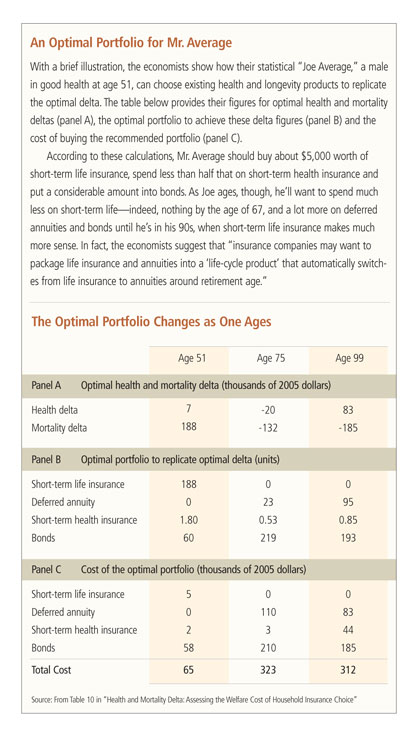Choosing a life insurance, supplemental health insurance or long-term care policy for ourselves or our families is a daunting intellectual exercise, complicated by deep emotion. Determining how to save toward retirement (rather than spending now) is equally demanding. Knowing how long one might live, what it may cost to do so, whether good health will continue and estimating the medical expenses if it doesn’t—all this involves intricate calculations of risk. Compounding the difficulty: a bewildering range of financial products that offer solutions to these personal conundrums.

Motohiro Yogo
Paralysis and procrastination are common responses to such complexity; many of us simply avoid decisions about household insurance. Aware of this reaction, advisers from insurance firms and financial funds stand at the ready, delighted to explain the benefits their products offer, but customers are well aware—or should be—that their advice may be less than objective.
Clear risk measures are available for stock and bond products themselves. For equities (and the mutual funds composed of them), a variable known as “beta” measures risk relative to the market’s overall average. For bonds, investors need look only at duration (short, intermediate or long term). While not foolproof, these yardsticks are invaluable tools for investment decisions.
A comparably simple and objective gauge for measuring relative risk of insurance products might be a great aid for those deciding which life or supplemental health or long-term care insurance policies to purchase, or where to build a nest egg through an annuity.
But for these household insurance decisions—in matters of, quite literally, life and death, and in sickness and health—there has been little in the way of disinterested guidance.
In a recent paper, “Health and Mortality Delta: Assessing the Welfare Cost of Household Insurance Choice,” economists Ralph Koijen of the University of Chicago, Stijn Van Nieuwerburgh at New York University and Motohiro Yogo from the Minneapolis Fed investigate this gap and develop two tools that individuals and advisers can use for unbiased judgments on the relative risk of life, supplemental health and long-term care insurance policies, as well as annuity products.1
They call their measures “health delta” and “mortality delta.” The former indicates the payoff that a given policy will provide to its owner should the owner suffer ill health. “The health delta at a certain age,” Koijen explained via email, “is the difference in the payoff of a financial product in poor health relative to being in good health in the next period.” And mortality delta is the difference in payoff between the holder being dead or alive at a specific age. (Thus, the term “delta,” which mathematicians and economists use to denote difference or change.)
“Each household has an optimal exposure to health and mortality delta that depends on preferences (e.g., risk aversion and bequest motive) and characteristics (e.g., birth cohort, age, health, and wealth),” write the economists. “Optimal portfolio choice simplifies to the problem of choosing a combination of health and longevity products, not necessarily unique, that replicates the optimal health and mortality delta.”
In addition, they estimate the financial benefit a household would reap from using these measures—put differently, the cost of not doing so. According to their calculations, this welfare cost is extremely high: 28 percent of the total wealth of a median household headed by a 51- to 58-year-old, and most of this value is accounted for by mortality delta—the choice of optimal life insurance or annuity plans, rather than health delta—supplementary health or long-term care insurance.
Finding delta
While the outcomes of their paper—both the deltas and their worth—are fairly straightforward, the process of discovery is rather complex. It begins with a model based on life-cycle theory—the idea that people’s consumption and savings preferences and patterns are shaped by their expected lifetime incomes.
The economists’ model therefore includes a family that faces risk of death and ill health that affects how long family members expect to live, how much they spend on health care and how much they value consumption and wealth. To prepare for the future, they can invest in a variety of household insurance policies, from life insurance to private annuity plans to health insurance policies that supplement government programs like Medicare.
In developing the model, the economists introduce their unique contribution: the deltas that represent health and mortality risk measures. Again, health delta measures the differential payoff that a policy delivers in poor health relative to good health, and mortality delta is a measure of differential payoff delivered at death relative to good health in the next period.
In a series of figures based on hypothetical policies, they illustrate the relative benefits of various household insurance choices. They find, for instance, that short-term life insurance generates high mortality delta per dollar invested relative to long-term life insurance. The same is true (in their hypothetical) for health insurance: “Short-term health insurance is a relatively inexpensive way to deliver wealth to poor health, especially for younger policyholders.”
The economists then derive an optimal solution to the life-cycle problem, under the reasonable assumption that “markets are complete” (that is, markets exist under all conditions for all products and assets at perfect equilibrium prices). The solution is “a useful theoretical benchmark,” they note. A household’s optimal portfolio choice of health and longevity products—given its specific preferences and unique characteristics—will replicate this optimal health and mortality delta solution.
Further, this benchmark helps them to develop a formula for measuring the cost when households deviate from the optimal insurance solution—either because markets aren’t complete (perhaps borrowing or portfolio constraints exist, or firms may not offer necessary products for households with certain characteristics) and/or households make suboptimal choices (perhaps because they lack the clear guidance that deltas offer).
Calibration and welfare cost
To bring greater realism to the research, the economists calibrate their model with data from a survey of U.S. households whose members are older, the Health and Retirement Study carried out by the Institute for Social Research at the University of Michigan. The economists focus particularly on households whose male respondent is age 51 and older when surveyed, and they calibrate with survey data on out-of-pocket health expenses (including insurance premiums), on income, on the face value of life insurance policies, on annuities (including pensions from employers) and on net worth. It’s crucial, of course, that they include the survey’s data on pricing and ownership of health and longevity products.
With the data from the survey, they’re able to calculate actual health and mortality risk or delta implied by each household’s ownership of longevity products (life insurance and annuities) and health products (supplemental health insurance and long-term care policies). With these calculations, they’re able to examine whether household characteristics explain variation in choices of such products and find that they probably don’t—that other factors such as incomplete markets or suboptimal choices are at play.
They then calculate the cost to the median household of deviating from the optimal solution. Again, the estimated cost is remarkably high: “The lifetime welfare cost for households aged 51 to 58 is 28.49 percent,” they write, “equivalent to a 28 percent reduction in lifetime consumption.” And deviations regarding longevity products such as life insurance and annuities, not health products, account for nearly all the reduction. Better guidance would clearly help.
Indeed, to demonstrate, the economists provide an example (see table) that shows how advisers and households can use deltas to shape an optimal portfolio.
Getting specific
The economists are quite pointed in their recommendations both to insurance companies and to household advisers. Companies, say the economists, should report health and mortality delta for the insurance products they offer. And financial advisers “should guide households on the optimal exposure to health and mortality delta over the life cycle, based on their preferences and characteristics.” This guidance should lead to improved decision making by households and better offerings from companies. “We hope that the introduction of these risk measures will facilitate standardization, identify overlap...identify risks that are not insured by existing products, and ultimately lead to new product development.”
Endnote
1 The paper and a video presentation are available online.






